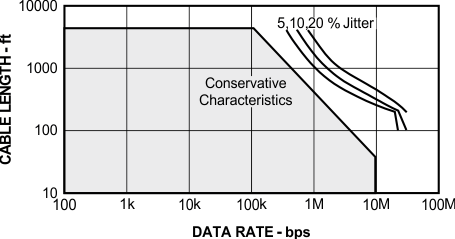ZHCSB94C July 2013 – January 2018 SN65HVD888
PRODUCTION DATA.
9.1.3 Cable Length Versus Data Rate
There is an inverse relationship between data rate and cable length, which means the higher the data rate, the shorter the cable length; and conversely, the lower the data rate the longer the cable length. While most RS-485 systems use data rates between 10 kbps and 100 kbps, applications such as e-metering often operate at rates of up to 250 kbps even at distances of 4000 ft and longer. Longer distances are possible by allowing for small signal jitter of up to 5 or 10%.
 Figure 17. Cable Length vs Data Rate Characteristic
Figure 17. Cable Length vs Data Rate Characteristic